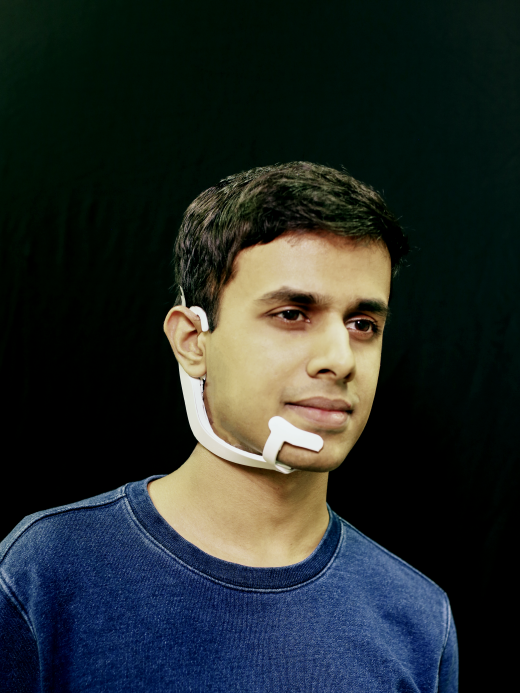
A prototype device called AlterEgo, created by MIT Media Lab graduate student Arnav Kapur, is already making this possible. With Kapur’s device—a 3-D-printed plastic doodad that looks kind of like a skinny white banana attached to the side of his head—he can flip through TV channels, change the colors of lightbulbs, make expert chess moves, solve complicated arithmetic problems, and, as he recently showed a 60 Minutes crew, order a pizza, all without saying a word or lifting a finger. It can be used to let people communicate silently and unobtrusively with each other, too.
“I do feel like a cyborg, but in the best sense possible,” he says of his experience with the device, which he built as a research project.
AlterEgo does not read minds, though it may sound that way. Rather, it picks up on the itty-bitty electrical signals produced by small movements of our facial and neck muscles when we silently read or talk to ourselves. AlterEgo’s electrodes capture these signals and send them via Bluetooth to a computer, where they can be decoded by algorithms and then acted on (“Turn on the light,” for example). The system includes bone conduction headphones to give you feedback and let you know (in a computerized voice) what other AlterEgo wearers are trying to tell you, without blocking your ears.
It’s like being personally connected to the Internet, and without it, Kapur says, “I feel normal all of a sudden.”
And Kapur, who would like to improve on this and turn it into a real product, is starting to think about all the issues that need to be fixed first.
For instance, its person-to-person communication function is limited to very simple words and phrases like “Yes,” “No,” “Hello,” “Bye,” and “Do you know this?” And while it can translate silently uttered words from English into languages including Spanish and Japanese, it’s still only able to translate 15 phrases.
That’s because his approach to silent speech is novel, so there aren’t any large data sets that the researchers can grab to train AlterEgo’s algorithm (as opposed to, say, say, a typical speech-recognition app). So the researchers are building their own data set by having people use it.
Kapur says they’re also setting up a study at hospitals and rehabilitation centers where people with speech impairments will use AlterEgo, though he won’t divulge what, exactly, they’re doing or hoping to find out. Beyond that, the researchers are expanding the vocabulary the system can understand, working on applications, and considering how they can improve AlterEgo’s form factor.
After all, he says, “it’s nice to have all those superpowers.”
source:-technologyreview.
